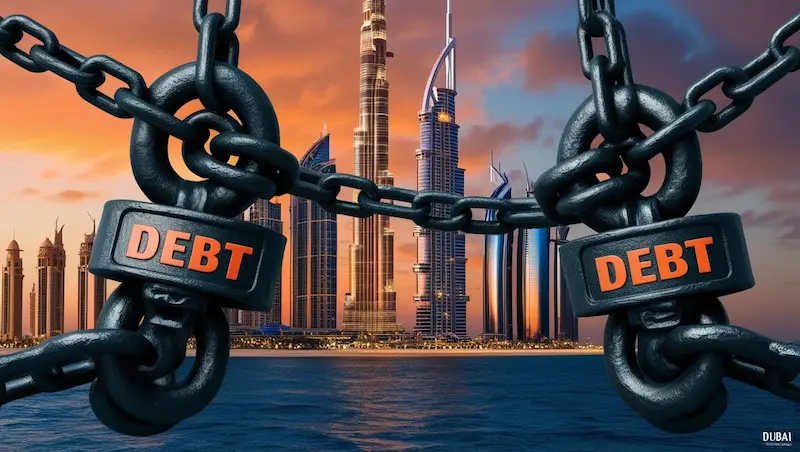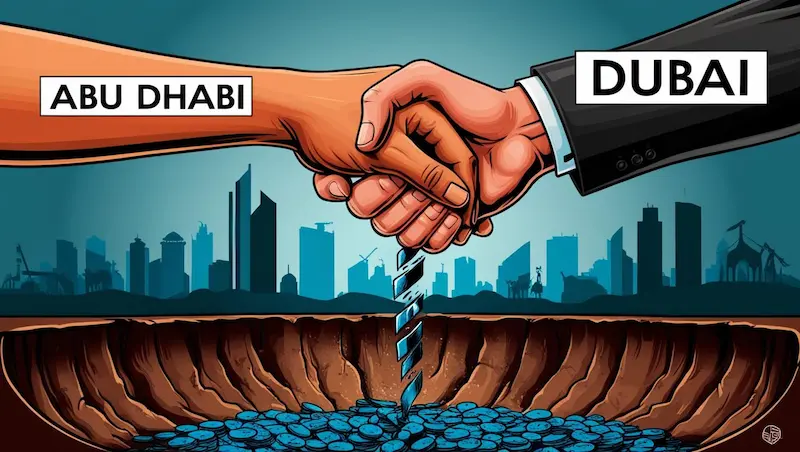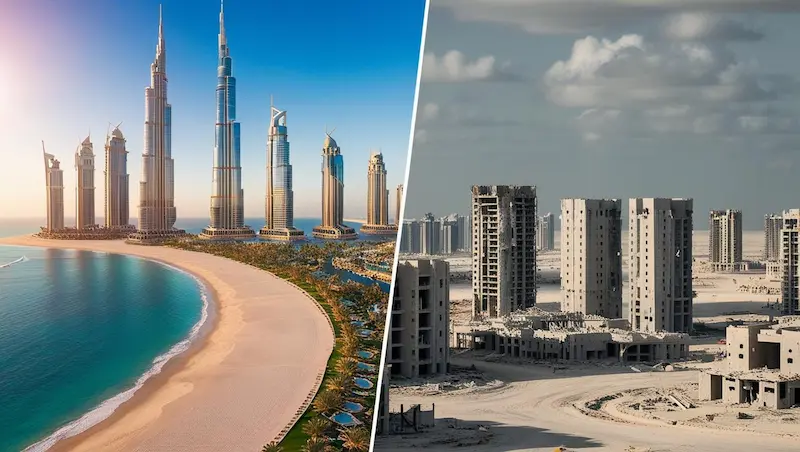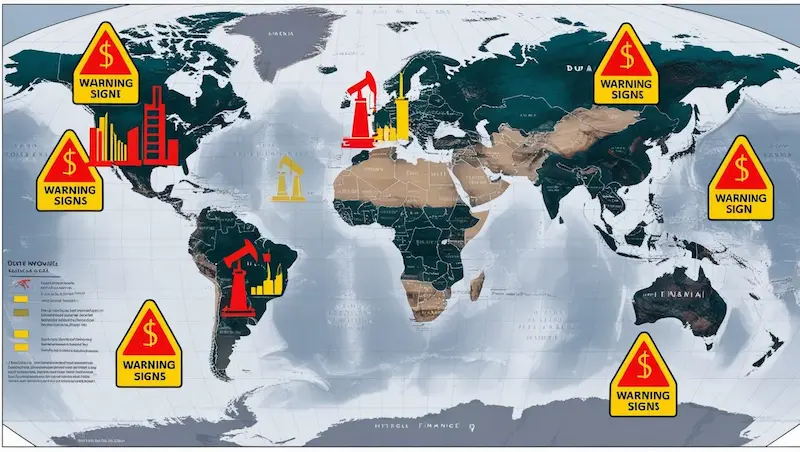
In 2009, Dubai, the city of dreams and architectural marvels, faced a nightmare that shook its glittering facade. Known for its towering skyscrapers and man-made islands, Dubai’s meteoric rise was fueled by borrowed money and unbridled ambition. But when the 2008 global financial crisis hit, the emirate’s real estate market collapsed, leaving it drowning in billions of dollars of debt. On the brink of financial ruin, Dubai turned to its oil-rich neighbor, Abu Dhabi, for a $10 billion bailout. This is not just a story of ambition gone wrong—it’s a cautionary tale for the world, offering lessons in debt management, economic diversification, and the dangers of speculative growth.
But how did one of the world’s most glamorous cities end up on the brink of collapse?
Dubai, the city of superlatives, where the world’s tallest tower pierces the sky and luxury knows no bounds, seemed unstoppable in the 2000s. But beneath the glitz and glamour lay a ticking time bomb of debt. When the 2008 global financial crisis hit, Dubai’s real estate market crumbled, leaving the emirate drowning in billions of dollars of unpaid loans. As the world watched in disbelief, Abu Dhabi stepped in with a $10 billion bailout, saving Dubai from financial ruin. This is the story of how ambition, over-leverage, and a global crisis brought Dubai to its knees—and how it clawed its way back.
Dubai didn’t technically “go bankrupt,” but it did face a severe financial crisis in 2009 that required a bailout from its wealthier neighbor, Abu Dhabi, part of the UAE federation. Here’s the scoop:
The Crisis:
Dubai’s economy was booming in the early 2000s, fueled by ambitious real estate projects, tourism, and its position as a global business hub. However, much of this growth was built on debt. Dubai borrowed heavily to fund massive infrastructure projects like the Burj Khalifa, Palm Jumeirah, and other iconic developments. When the 2008 global financial crisis hit, the real estate market in Dubai collapsed, with property prices plummeting by up to 50%. This left Dubai’s state-owned companies, particularly Dubai World, struggling to repay their debts, which totaled around $80 billion.
The Bailout:
In late 2009, Dubai World announced it needed to restructure $26 billion of its debt, sending shockwaves through global markets. To prevent a default, Abu Dhabi stepped in with a $10 billion bailout, which helped Dubai meet its immediate obligations. In return, Abu Dhabi gained more influence over Dubai, including renaming the Burj Dubai to Burj Khalifa, after Abu Dhabi’s ruler, Sheikh Khalifa bin Zayed Al Nahyan.
Why Did Abu Dhabi Help?
Abu Dhabi, with its vast oil wealth, had a vested interest in stabilizing Dubai. A financial collapse in Dubai could have tarnished the reputation of the UAE as a whole, scaring off investors and damaging the federation’s economy. By stepping in, Abu Dhabi ensured the UAE’s global standing remained intact.

Lessons Learned:
Since then, Dubai has diversified its economy further, focusing on tourism, trade, and technology, while managing its debt more cautiously. However, its reliance on real estate and external financing remains a point of vulnerability.
In short, Dubai’s financial troubles were a mix of overambition, heavy borrowing, and the global economic downturn. Abu Dhabi’s bailout was a strategic move to protect the UAE’s broader interests.
Where Does Dubai Stand in the UAE?
Dubai is one of the seven emirates that make up the United Arab Emirates (UAE), a country located in the Middle East. The UAE was formed in 1971, and Dubai is the second-largest emirate (after Abu Dhabi, which is the capital).
Key Points:
- Dubai is a city and an emirate within the UAE.
- The UAE is a federation of seven emirates: Abu Dhabi, Dubai, Sharjah, Ajman, Umm Al-Quwain, Fujairah, and Ras Al Khaimah.
- Each emirate has a degree of autonomy, with its own ruler (called a Sheikh), but they all come under the federal government of the UAE.
- Abu Dhabi is the political and financial powerhouse of the UAE, thanks to its vast oil reserves, while Dubai is known for its trade, tourism, and real estate.
Lessons from Dubai’s Financial Crisis
Avoid Over-Reliance on Real Estate Speculation
Dubai’s crisis was fueled by speculative investments in real estate, with foreign capital pouring into unsustainable projects. When the global financial crisis hit, property prices plummeted, and Dubai’s debt-fueled growth model collapsed.
Lesson: Countries must regulate speculative bubbles in real estate and ensure sustainable urban development.Diversify the Economy
While Dubai had diversified beyond oil, its heavy reliance on real estate and tourism left it vulnerable. The crisis highlighted the need for a balanced economy with multiple revenue streams.
Lesson: India and other nations should focus on diversifying their economies, investing in technology, manufacturing, and green energy to reduce dependency on volatile sectors.Prudent Debt Management
Dubai’s state-owned enterprises (SOEs) borrowed heavily without centralized oversight, leading to a debt crisis. The lack of a public debt management framework exacerbated the problem.
Lesson: Governments must monitor and regulate borrowing by public and private entities, ensuring transparency and accountability.Strengthen Financial Oversight
Dubai’s crisis exposed weak regulatory frameworks, particularly in real estate and banking. The absence of centralized control over foreign borrowing and asset-liability mismatches worsened the situation.
Lesson: Robust financial regulations and oversight mechanisms are critical to prevent systemic risks.Prepare for External Shocks
Dubai’s open economy made it highly susceptible to global financial shocks. The crisis underscored the importance of building economic resilience.
Lesson: Countries like India should develop counter-cyclical fiscal policies and maintain foreign exchange reserves to cushion against global downturns.Transparency and Governance
The crisis revealed a lack of corporate governance and transparency in Dubai’s SOEs, which undermined investor confidence.
Lesson: Strong governance, clear policies, and transparent financial practices are essential for long-term stability.

Did Other Countries Make Similar Mistakes?
Yes, several countries have faced crises due to similar missteps:
United States (2008 Subprime Mortgage Crisis)
- The U.S. housing bubble, fueled by speculative lending and unregulated financial instruments, triggered the global financial crisis.
- Similarity: Like Dubai, the U.S. relied on unsustainable real estate growth and weak oversight of financial institutions.
Greece (2010 Sovereign Debt Crisis)
- Greece’s excessive borrowing and lack of fiscal discipline led to a debt crisis, requiring bailouts from the EU and IMF.
- Similarity: Like Dubai, Greece lacked a robust debt management framework and relied on external financing.
Spain and Ireland (2008-2010 Real Estate Crises)
- Both countries experienced real estate bubbles fueled by speculative investments and easy credit, leading to banking crises.
- Similarity: Over-reliance on real estate and weak financial oversight mirrored Dubai’s mistakes.
China (Ongoing Real Estate Issues)
- China’s property sector, led by companies like Evergrande, has faced debt crises due to over-leveraging and speculative growth.
- Similarity: Like Dubai, China’s real estate boom has created systemic risks tied to debt and speculative investments.
How Can India Avoid These Pitfalls?
Regulate Real Estate and Lending
India must ensure stricter regulations in real estate and banking to prevent speculative bubbles. Policies like RERA (Real Estate Regulatory Authority) are steps in the right direction.Diversify Economic Growth
India should reduce reliance on specific sectors like IT or agriculture and invest in manufacturing, renewable energy, and technology-driven industries.Strengthen Debt Management
Both public and private debt must be monitored. India should avoid excessive borrowing, especially in foreign currencies, and establish a robust debt management framework.Build Resilience Against External Shocks
Maintaining healthy foreign exchange reserves, reducing fiscal deficits, and fostering domestic demand can help India withstand global crises.Focus on Governance and Transparency
Strengthening corporate governance, improving ease of doing business, and ensuring transparency in public and private sectors will boost investor confidence.

Conclusion
Dubai’s financial crisis serves as a cautionary tale of unchecked ambition, speculative growth, and weak oversight. While countries like the U.S., Greece, and China have faced similar challenges, the lessons are clear: economic diversification, prudent debt management, and robust governance are non-negotiable for sustainable growth. For India, adopting these principles can help avoid similar pitfalls and build a resilient, future-ready economy.




